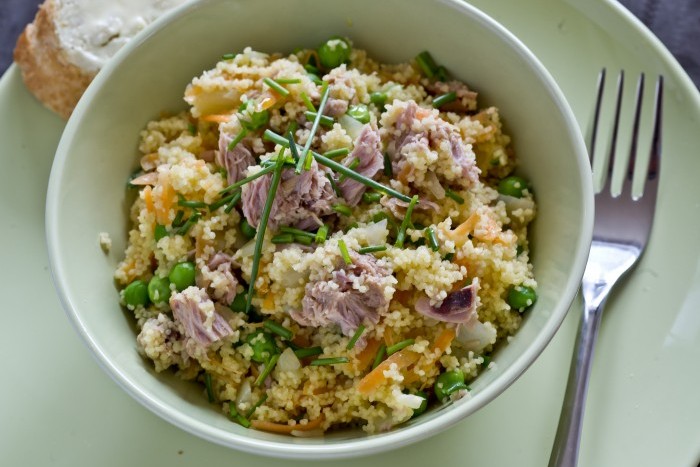A lovely mix of flavours and textures combine to form this delicious dish which can be eaten hot or cold. Quick and easy and made from store cupboard staples this recipe is a winner all round.
Skills Check
Follow a recipe; follow food safety & hygiene rules; tidy away; use a jug to measure liquids; use balance/digital scales; cut using bridge/claw technique safely; snip herbs with scissors; use a vegetable peeler safely; use a box grater safely; use a colander; season to taste.
Equipment
Mixing bowl, Spoon, Measuring Spoons, Weighing Scales, Vegetable Peeler, Box Grater, Citrus Squeezer/Zester, Scissors, Jug, Lid/Plate/Clingfilm, Tin Opener, Sieve/Colander, Fork, Kettle.
Allergens:
Wheat | Gluten | Fish
Please note the allergens listed are indicative only. Allergens vary depending on brand; check the labels on the products you use.
Ingredients (serves 2):
- 180g can tuna in spring water, drained
- 1 tsp olive oil
- 2 spring onions, snipped
- 1 carrot, peeled and grated
- 80g frozen peas
- Zest and juice of 1/2 lemon
- 2 tsp chopped chives
- 185g dry couscous
Method
- Place all of the ingredients, except the tuna, into a bowl and mix well.
- Add 250ml boiling water to just cover the ingredients and mix again. Cover the bowl with a tight lid, plate or clingfilm to keep the heat in and leave for approximately 5 minutes, or until all of the liquid has been absorbed.
- Separate the tuna into flakes and stir through the couscous mixture.
- Season well and serve hot or cold.
So thinking about Tuna Couscous...

Couscous is coarsely ground wheat (semolina) rolled in wheat flour and is a staple food throughout North Africa. It is low in calories and fat. Wholegrain varieties are available.
Nutritional Information
| - | Energy | 1464KJ/346kcal | 17% |
| Low | Fat | 4.1g | 6% |
| Low | Saturates | 0.7g | 4% |
| Low | Sugars | 5.2g | 6% |
| Low | Salt | 0.11g | 2% |
per 268g serving
% of an adult's reference intake
Typical values per 100g: Energy 546KJ / 129kcal
Notes
A traffic light system is used on nutrition labels to make it easier to see which foods and drinks are lower in calories, fat, sugar and salt. Try and choose more ‘greens’ and ‘ambers’ and fewer ‘reds’, and stick to smaller portions of ‘reds’.
Just because a recipe or a food has a red traffic light doesn't mean you shouldn't eat it. Understanding why a food or recipe might have a red light can be helpful. For example oily fish is high in total fat and so any recipe containing oily fish is likely to be ‘red’ for fat. But it is recommended that we eat oily fish at least once a week because the type of fat it contains is beneficial for our health.
% Reference Intakes are also shown. Reference Intakes are guidelines about the approximate amount of particular nutrients and energy required for a healthy diet (based on an average-sized woman doing an average amount of physical activity). Most children will require less than these Reference Intakes. The contribution of one serving of a food or drink to the Reference Intake for each nutrient is expressed as a percentage.




